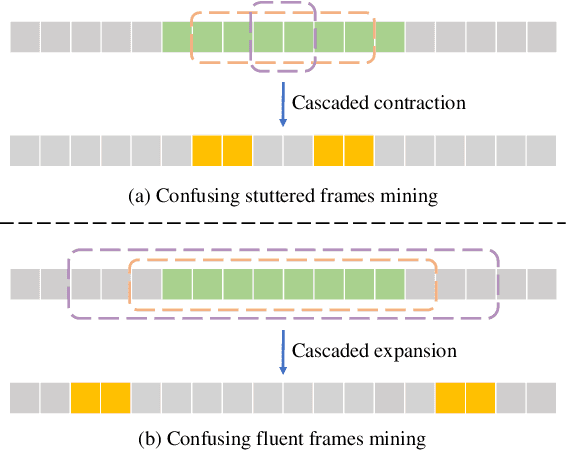Yiquan Zhou
SYKI-SVC: Advancing Singing Voice Conversion with Post-Processing Innovations and an Open-Source Professional Testset
Jan 06, 2025Abstract:Singing voice conversion aims to transform a source singing voice into that of a target singer while preserving the original lyrics, melody, and various vocal techniques. In this paper, we propose a high-fidelity singing voice conversion system. Our system builds upon the SVCC T02 framework and consists of three key components: a feature extractor, a voice converter, and a post-processor. The feature extractor utilizes the ContentVec and Whisper models to derive F0 contours and extract speaker-independent linguistic features from the input singing voice. The voice converter then integrates the extracted timbre, F0, and linguistic content to synthesize the target speaker's waveform. The post-processor augments high-frequency information directly from the source through simple and effective signal processing to enhance audio quality. Due to the lack of a standardized professional dataset for evaluating expressive singing conversion systems, we have created and made publicly available a specialized test set. Comparative evaluations demonstrate that our system achieves a remarkably high level of naturalness, and further analysis confirms the efficacy of our proposed system design.
FGCL: Fine-grained Contrastive Learning For Mandarin Stuttering Event Detection
Oct 08, 2024



Abstract:This paper presents the T031 team's approach to the StutteringSpeech Challenge in SLT2024. Mandarin Stuttering Event Detection (MSED) aims to detect instances of stuttering events in Mandarin speech. We propose a detailed acoustic analysis method to improve the accuracy of stutter detection by capturing subtle nuances that previous Stuttering Event Detection (SED) techniques have overlooked. To this end, we introduce the Fine-Grained Contrastive Learning (FGCL) framework for MSED. Specifically, we model the frame-level probabilities of stuttering events and introduce a mining algorithm to identify both easy and confusing frames. Then, we propose a stutter contrast loss to enhance the distinction between stuttered and fluent speech frames, thereby improving the discriminative capability of stuttered feature embeddings. Extensive evaluations on English and Mandarin datasets demonstrate the effectiveness of FGCL, achieving a significant increase of over 5.0% in F1 score on Mandarin data.
VITS-based Singing Voice Conversion System with DSPGAN post-processing for SVCC2023
Oct 08, 2023Abstract:This paper presents the T02 team's system for the Singing Voice Conversion Challenge 2023 (SVCC2023). Our system entails a VITS-based SVC model, incorporating three modules: a feature extractor, a voice converter, and a post-processor. Specifically, the feature extractor provides F0 contours and extracts speaker-independent linguistic content from the input singing voice by leveraging a HuBERT model. The voice converter is employed to recompose the speaker timbre, F0, and linguistic content to generate the waveform of the target speaker. Besides, to further improve the audio quality, a fine-tuned DSPGAN vocoder is introduced to re-synthesise the waveform. Given the limited target speaker data, we utilize a two-stage training strategy to adapt the base model to the target speaker. During model adaptation, several tricks, such as data augmentation and joint training with auxiliary singer data, are involved. Official challenge results show that our system achieves superior performance, especially in the cross-domain task, ranking 1st and 2nd in naturalness and similarity, respectively. Further ablation justifies the effectiveness of our system design.
 Add to Chrome
Add to Chrome Add to Firefox
Add to Firefox Add to Edge
Add to Edge